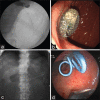Endoscopic management of pancreatic fluid collections with disconnected pancreatic duct syndrome
- PMID: 36861506
- PMCID: PMC10134920
- DOI: 10.4103/EUS-D-21-00272
Endoscopic management of pancreatic fluid collections with disconnected pancreatic duct syndrome
Abstract
Disconnected pancreatic duct syndrome (DPDS) is an important and common complication of acute necrotizing pancreatitis. Endoscopic approach has been established as the first-line treatment for pancreatic fluid collections (PFCs) with less invasion and satisfactory outcome. However, the presence of DPDS significantly complicates the management of PFC; besides, there is no standardized treatment for DPDS. The diagnosis of DPDS presents the first step of management, which can be preliminarily established by imaging methods including contrast-enhanced computed tomography, ERCP, magnetic resonance cholangiopancreatography (MRCP), and EUS. Historically, ERCP is considered as the gold standard for the diagnosis of DPDS, and secretin-enhanced MRCP is recommended as an appropriate diagnostic method in existing guidelines. With the development of endoscopic techniques and accessories, the endoscopic approach, mainly including transpapillary and transmural drainage, has been developed as the preferred treatment over percutaneous drainage and surgery for the management of PFC with DPDS. Many studies concerning various endoscopic treatment strategies have been published, especially in the recent 5 years. Nonetheless, existing current literature has reported inconsistent and confusing results. In this article, the latest evidence is summarized to explore the optimal endoscopic management of PFC with DPDS.
Keywords: disconnected pancreatic duct syndrome; necrotizing pancreatitis; pancreatic fluid collections; pancreatic pseudocysts; walled-off necrosis.
Conflict of interest statement
None
Figures



References
-
- Boxhoorn L, Voermans RP, Bouwense SA, et al. Acute pancreatitis. Lancet. 2020;396:726–34. - PubMed
-
- Pelaez-Luna M, Vege SS, Petersen BT, et al. Disconnected pancreatic duct syndrome in severe acute pancreatitis:Clinical and imaging characteristics and outcomes in a cohort of 31 cases. Gastrointest Endosc. 2008;68:91–7. - PubMed
-
- Trikudanathan G, Wolbrink DR, van Santvoort HC, et al. Current concepts in severe acute and necrotizing pancreatitis:An evidence-based approach. Gastroenterology. 2019;156:1994–2007. e3. - PubMed
-
- Verma S, Rana SS. Disconnected pancreatic duct syndrome:Updated review on clinical implications and management. Pancreatology. 2020;20:1035–44. - PubMed
Publication types
LinkOut - more resources
Full Text Sources
Miscellaneous

